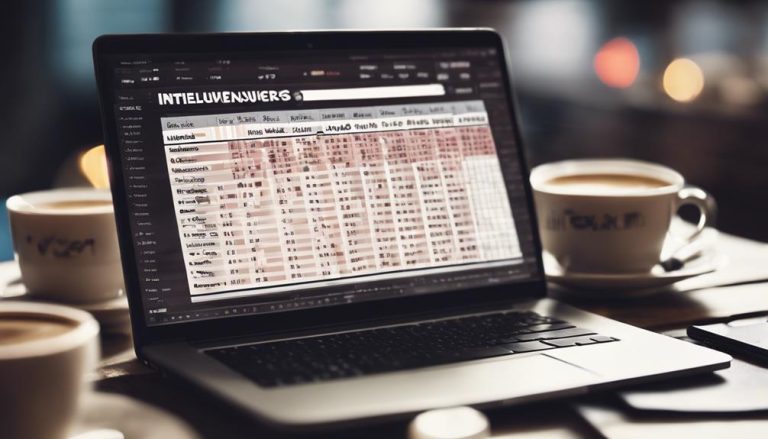Influencer Marketing Partnership ROI Measurement
When evaluating the success of your influencer marketing partnerships, it's not just about eyeballing the number of followers or likes an influencer has – it's about calculating the real ROI. But here's the catch: measuring influencer marketing ROI is trickier than you might think. Without a clear definition of what constitutes ROI, and the right tools to track performance, it's hard to determine whether those Instagram posts are truly paying off. Are you tracking the metrics that really matter, or are you missing a key piece of the puzzle that's hindering your partnership's success?
Key Takeaways
- To measure influencer marketing partnership ROI, track engagement rates, click-through rates, and conversion rates.
- Clearly define influencer marketing goals and objectives to accurately calculate ROI.
- Use attribution modeling and tracking to understand the true impact of each influencer on sales.
- Key performance indicators (KPIs) must be outlined and aligned with marketing goals to measure success.
Defining Influencer Marketing ROI
When evaluating the effectiveness of an influencer marketing campaign, you'll want to define return on investment (ROI) as the net gain in revenue or conversions generated by the partnership, minus the costs associated with the collaboration.
To accurately calculate ROI, having a thorough understanding is crucial to have a clear influencer definition in place. This definition should outline the specific goals and objectives of the partnership, as well as the key performance indicators (KPIs) that will be used to measure success.
Content evaluation is also a critical component of ROI measurement. You'll want to assess the quality and engagement of the content created by the influencer, as well as its alignment with your brand's messaging and goals.
This can involve analyzing metrics such as engagement rates, click-through rates, and conversion rates. By incorporating these metrics into your ROI calculation, you'll be able to gain a more in-depth understanding of the campaign's effectiveness and make data-driven decisions about future partnerships.
Common ROI Measurement Challenges
When measuring the ROI of your influencer marketing partnerships, you'll likely encounter several challenges that can impact the accuracy of your analysis.
You'll need to figure out how to effectively track attribution models, which can be complex and nuanced, to understand the true impact of each influencer on your sales.
Additionally, data quality issues and difficulties in measuring an influencer's impact on your brand's overall performance will also require careful consideration.
Tracking Attribution Models
Measuring the effectiveness of influencer marketing partnerships often hinges on the attribution model you use, but selecting the right one can be a formidable task due to the complexity of tracking multiple touchpoints across various channels.
You need to take into account the various interactions a customer has with your brand, from social media to website visits, before making a purchase.
To accurately attribute the influence of each touchpoint, you'll want to leverage data-driven approaches.
- Predictive modeling: Use statistical models to forecast the likelihood of a conversion based on historical data and customer behavior.
- Machine learning algorithms: Implement machine learning algorithms to analyze large datasets and identify patterns that inform attribution decisions.
- Multi-touch attribution: Assign credit to each touchpoint in the customer journey, rather than just the last click.
- Data integration: Combine data from various sources, including social media, CRM, and website analytics, to get an exhaustive view of customer interactions.
Measuring Influencer Impact
As you dig into calculating the return on investment (ROI) of your influencer marketing partnerships, you'll likely encounter a set of common challenges that can hinder your ability to accurately assess the impact of your influencer relationships.
One of the primary obstacles is measuring the effectiveness of influencer niche targeting. With numerous influencers operating within the same niche, it can be difficult to determine which partnerships are driving the most value. Additionally, content style variations can also pose a challenge. Influencers often experiment with different content formats, such as videos, blog posts, or social media stories, making it hard to compare apples to apples.
To overcome these challenges, it's crucial to establish clear key performance indicators (KPIs) that align with your marketing goals. This may include metrics such as engagement rates, website traffic, or conversion rates.
Data Quality Issues
Data quality issues can substantially skew your influencer marketing partnership ROI calculations, making it essential to identify and address common problems such as incomplete or inaccurate tracking codes, inconsistent data formatting, and discrepancies in attribution modeling.
When you're working with multiple data sources and stakeholders, it's easy for errors to creep in and affect your analysis.
To guarantee accurate ROI calculations, you'll want to implement robust data validation and governance processes.
- Verify tracking codes: Double-check that all tracking codes are correctly implemented and firing as expected.
- Standardize data formatting: Confirm that all data sources are using a consistent format for date, time, and currency fields, among others.
- Reconcile attribution modeling: Review your attribution modeling to guarantee that it accurately reflects the customer journey and isn't over- or under-crediting certain touchpoints.
- Monitor data quality metrics: Regularly track data quality metrics, such as error rates and data completeness, to identify and address issues proactively.
Setting Partnership Goals
When establishing an influencer marketing partnership, you must clearly define what you want to achieve, setting specific, measurable goals that align with your overall business objectives.
This involves outlining the partnership scope, including the influencer's role, responsibilities, and expected outcomes. A well-structured influencer contract should also be in place, detailing the terms of the partnership, including the duration, compensation, and expectations.
To set effective partnership goals, you should consider your business objectives, target audience, and the influencer's strengths and weaknesses.
Ask yourself what specific actions you want the influencer to take, what kind of content you want them to create, and what kind of engagement you want to drive. Be specific and measurable in your goals, using metrics such as reach, impressions, clicks, or conversions.
By setting clear goals, you can guarantee that your influencer marketing partnership is aligned with your overall marketing strategy and is working towards achieving your business objectives.
A well-defined partnership scope and contract will also help prevent misunderstandings and guarantee a successful collaboration.
Choosing Key Performance Indicators
Now that you've established clear partnership goals, you need to define the key performance indicators (KPIs) that will help you measure the success of your influencer marketing partnership. Choosing the right KPIs is vital to evaluating the effectiveness of your partnership and making data-driven decisions.
When selecting KPIs, consider the following factors:
- Influencer alignment: Does the influencer's content and audience align with your brand values and target audience?
- Partnership customization: Are the KPIs tailored to the specific goals and objectives of your partnership?
- Measurable outcomes: Can the KPIs be quantifiably measured and tracked?
- Actionable insights: Do the KPIs provide actionable insights that inform future partnership decisions?
Tracking Influencer Campaign Metrics
Your campaign's performance metrics are the backbone of a successful influencer marketing partnership, and tracking them effectively is crucial to measuring ROI and informing future strategy.
To do this, you'll need to establish a system for monitoring key metrics, such as engagement rates, click-through rates, and conversions. This data will help you understand what's working and what's not, allowing you to make data-driven decisions to optimize your campaign.
When tracking influencer campaign metrics, it's imperative to refer back to your influencer contract to confirm you're meeting the agreed-upon goals and objectives.
This contract should outline specific metrics and benchmarks for success, providing a clear framework for evaluation. By regularly tracking and analyzing these metrics, you'll be able to identify areas for campaign optimization, such as adjusting your targeting strategy or tweaking your content approach.
This data-driven approach will enable you to refine your campaign and maximize ROI. By leveraging these insights, you'll be able to make informed decisions and drive meaningful results from your influencer marketing partnership.
Measuring Brand Awareness Impact
To accurately measure the impact of an influencer marketing partnership on brand awareness, you'll need to track metrics such as social media follower growth, hashtag engagement, and brand mentions. This will help you understand how the partnership is affecting your brand's visibility and reputation.
Four key metrics to track when measuring brand awareness impact are:
1. Social media follower growth rate: Monitor the increase in followers across different social media platforms to see if the partnership is attracting new audiences.
2. Hashtag engagement: Track the number of times the branded hashtag is used, as well as the engagement rate (likes, comments, etc.) on posts using the hashtag.
3. Brand mentions: Measure the number of times your brand is mentioned in social media conversations, including both tagged and untagged mentions.
4. Social proof metrics: Track metrics such as influencer content engagement rates, influencer audience demographics, and content saves to gauge social proof and brand affinity.
Calculating Sales and Revenue
When evaluating the sales and revenue generated from your influencer marketing partnerships, you'll need to track affiliate sales and measure direct revenue.
To do this, you'll want to set up affiliate links or promo codes that allow you to attribute sales to specific influencers.
Tracking Affiliate Sales
One key performance indicator (KPI) for measuring the success of an influencer marketing partnership is tracking affiliate sales, which involves calculating the number of sales generated and revenue earned through affiliate links.
As an influencer marketer, you need to monitor affiliate sales to evaluate the effectiveness of your partnership.
To track affiliate sales effectively, you should set up affiliate links and create unique affiliate links for each influencer partner to track sales generated from their social media promotions.
Use affiliate networks like ShareASale or Commission Junction to manage affiliate links, track sales, and receive commission payments.
Monitor affiliate dashboards regularly to view real-time sales data, conversion rates, and revenue earned from affiliate links.
Analyze sales data to identify top-performing influencers, products, and promotional channels, and adjust your strategy accordingly.
Measuring Direct Revenue
Beyond tracking affiliate sales, measuring direct revenue generated from influencer marketing partnerships is equally important, as it provides a more thorough picture of the campaign's financial performance.
You'll want to calculate the sales and revenue generated directly from the partnership, such as through social commerce or sponsored content creation. To do this, you'll need to track the number of sales, revenue, and conversion rates generated from the partnership.
You can use metrics such as return on ad spend (ROAS) and return on investment (ROI) to evaluate the financial performance of the partnership.
For example, if you spent $10,000 on an influencer partnership and generated $50,000 in revenue, your ROAS would be 500%.
This data will help you understand the effectiveness of your influencer marketing strategy and make data-driven decisions for future campaigns.
Evaluating Partnership Cost Effectiveness
To accurately evaluate the cost effectiveness of an influencer marketing partnership, you must compare the total costs incurred – including fees, content creation expenses, and campaign management costs – against the revenue generated from the partnership. This requires a thorough cost analysis to determine the return on investment (ROI) of the partnership.
When conducting a partnership evaluation, consider the following key cost components:
- Influencer fees: The cost of partnering with the influencer, including any upfront payments or commissions.
- Content creation expenses: The cost of producing content for the partnership, such as video production or photography.
- Campaign management costs: The cost of managing the partnership, including personnel, software, and other overhead expenses.
- Tracking and measurement tools: The cost of tools used to track the partnership's performance, such as affiliate links or promo codes.
Optimizing Future Partnerships
By analyzing the ROI of past partnerships and identifying areas for improvement, you can refine your influencer marketing strategy to maximize the effectiveness of future collaborations. To optimize future partnerships, a crucial step is to conduct influencer audits to assess the performance of your current influencer roster. This involves evaluating their content quality, engagement rates, and audience demographics to determine which influencers are driving the most value for your brand.
| Influencer Metric | Target Threshold | Actual Performance |
|---|---|---|
| Engagement Rate | 2% | 1.8% |
| Content Quality Score | 80 | 78 |
| Audience Demographics | 70% alignment | 65% alignment |
| Cost per Acquisition | $50 | $60 |
| Return on Ad Spend | 200% | 180% |
Frequently Asked Questions
How to Measure ROI for Non-Sales Focused Influencer Campaigns?
When measuring ROI for non-sales focused campaigns, you track engagement metrics, such as likes, comments, and saves. You also monitor brand sentiment through social listening, analyzing mentions, and emotions associated with your brand to gauge campaign success.
Can Influencer Marketing ROI Be Compared to Traditional Advertising Roi?
You're comparing apples to oranges when measuring ROI across media channels. Traditional advertising ROI is often based on standardized metrics, whereas influencer marketing ROI requires customized metrics, making direct comparisons challenging without common Advertising Standards.
What Is the Average ROI for Influencer Marketing Partnerships?
When evaluating partnerships, you'll find that average returns vary widely. According to influencer benchmarks, you can expect a median ROI of 3-5:1, with top performers reaching up to 10:1, indicating significant variations in partnership effectiveness.
How to Account for Organic Sales in Influencer Marketing ROI Calculations?
You'll need to isolate organic sales by using controlled cohorts and subtracting the discount impact to accurately attribute sales to the influencer marketing campaign, ensuring a more precise ROI calculation that reflects the campaign's true effectiveness.
Can Influencer Marketing ROI Be Measured Without Promo Codes or Affiliate Links?
You can measure ROI without promo codes or affiliate links by using influencer alternatives like tracking pixels, which monitor website traffic and conversions, providing a more accurate picture of campaign effectiveness and return on investment.
Conclusion
You've successfully measured the ROI of your influencer marketing partnership by defining clear goals, choosing relevant KPIs, and tracking campaign metrics.
By calculating sales and revenue, you've evaluated the cost-effectiveness of the partnership.
Use this data to optimize future collaborations, allocating resources to influencers who drive the greatest returns.
Continuously refine your approach to maximize ROI and achieve a stronger bottom line.
Data-driven decision making is key to influencer marketing success.







